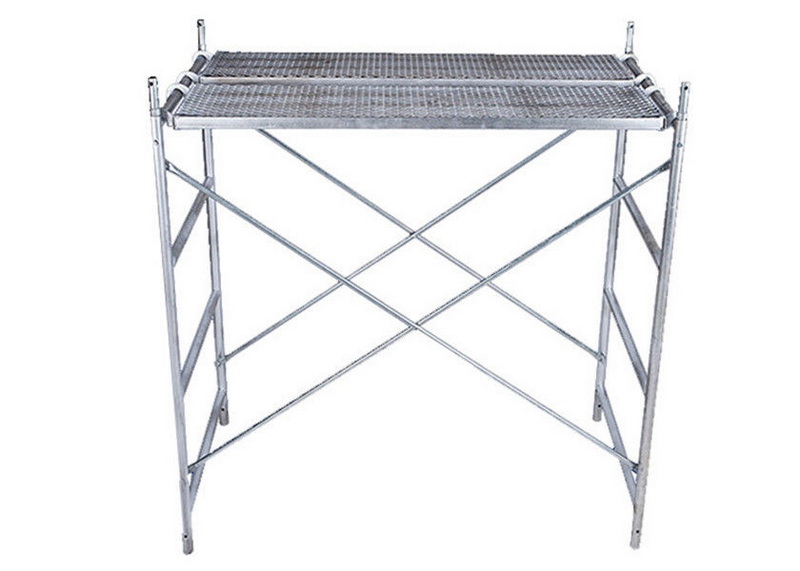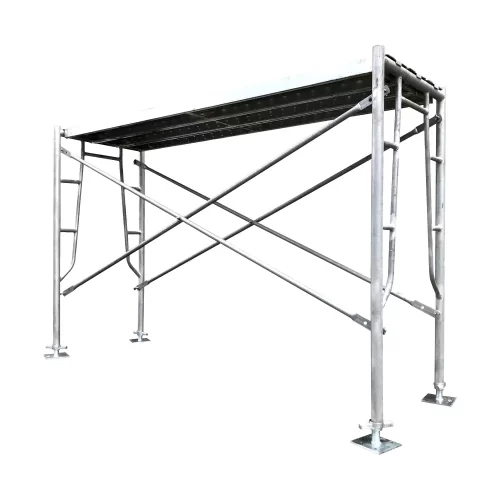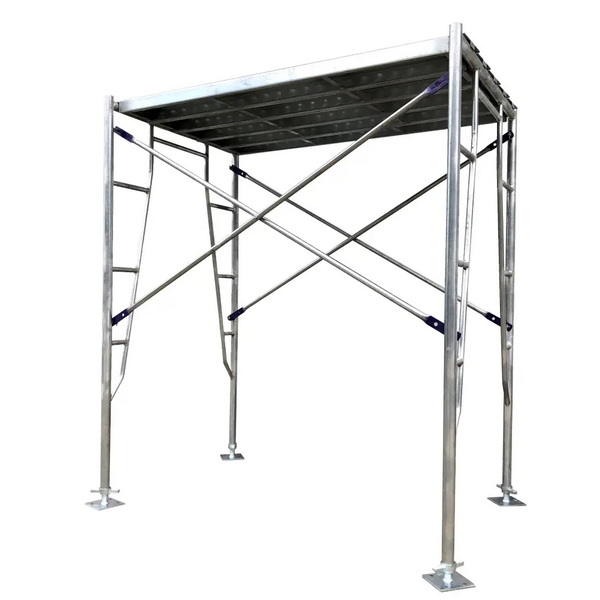Content Menu
● Introduction to Frame Scaffolding
● Advantages of Frame Scaffolding
● Step-by-Step Guide to Setting Up Frame Scaffolding
>> Step 1: Prepare the Site
>> Step 2: Assemble the Base
>> Step 3: Add Frames and Bracing
>> Step 4: Install Platforms and Guardrails
>> Step 5: Final Safety Check
● Safety Considerations
● Additional Safety Measures
● Best Practices for Maintenance
● Conclusion
● FAQ
>> 1. What are the key components of a frame scaffolding?
>> 2. How often should I inspect the scaffolding?
>> 3. Can I use frame scaffolding near power lines?
>> 4. What is the maximum height for a frame scaffolding without ties?
>> 5. How do I ensure the scaffolding is level and plumb?
● Citations:
Setting up a frame scaffolding safely is crucial for ensuring the well-being of workers and the stability of the structure. This comprehensive guide will walk you through the process step by step, highlighting key safety considerations and best practices.

Introduction to Frame Scaffolding
Frame scaffolding is a common type of scaffolding used in construction and maintenance projects. It consists of pre-fabricated frames that are connected to form a stable structure. The frames are typically made of metal and are designed to support various types of platforms, guardrails, and other components.
Advantages of Frame Scaffolding
- Easy to Assemble: Frame scaffolding is relatively simple to set up and dismantle, making it a popular choice for projects with tight deadlines.
- Versatile: It can be used for a variety of tasks, from painting to bricklaying, due to its ability to support different types of platforms and materials.
- Cost-Effective: Compared to other types of scaffolding, frame scaffolding is often more affordable and can be reused multiple times.
Step-by-Step Guide to Setting Up Frame Scaffolding
Step 1: Prepare the Site
Before assembling the scaffolding, ensure the ground is level, firm, and free from obstructions. Use base plates or mud sills to stabilize the scaffolding on uneven or soft surfaces. It's also important to check for any underground utilities or obstructions that might interfere with the scaffolding's stability.
Step 2: Assemble the Base
1. Lay Out Base Plates: Position the base plates according to the desired shape and size of your scaffolding. Secure them together using bolts. Ensure that the base plates are evenly spaced and aligned to prevent any instability.
2. Attach Vertical Pipes: Connect vertical pipes to the center of each base plate. Use elbow or T joints to join multiple pipes together. Make sure all connections are securely tightened to prevent any movement.
Step 3: Add Frames and Bracing
1. Erect Frames: Place the frame scaffolding units on the vertical pipes, ensuring they are square and level. Use a spirit level to double-check. It's crucial to ensure that each frame is properly aligned with the next to maintain structural integrity.
2. Install Bracing: Add horizontal and diagonal bracing to stabilize the structure. Ensure all connections are securely bolted or pinned. Proper bracing is essential to prevent the scaffolding from swaying or collapsing.
Step 4: Install Platforms and Guardrails
1. Place Platforms: Ensure platforms are fully decked and secured to prevent movement. Use scaffold-grade wood planking or fabricated platforms. The platforms should be able to support the weight of workers and materials safely.
2. Install Guardrails: Provide a guardrail system around the perimeter of each working level. Ensure guardrails are 42 to 45 inches high with a mid-rail. Guardrails are critical for preventing falls and should be installed according to local safety regulations.
Step 5: Final Safety Check
Before using the scaffolding, perform a thorough safety inspection:
- Base Stability: Confirm base plates are firmly in contact with the ground.
- Frame and Bracing: Ensure all connections are secure.
- Guardrails: Verify guardrails are properly installed.
- Access: Provide safe access via ladders or stairways.

Safety Considerations
Safety is paramount when setting up and using a frame scaffolding. Common hazards include:
- Undermining the Base: Ensure the ground can support the weight of the scaffolding.
- Removing Critical Components: Never remove guardrails, planks, or bracing without proper authorization.
- Overloading: Do not exceed the maximum intended load.
Additional Safety Measures
- Weather Conditions: Avoid using scaffolding during strong winds, heavy rain, or icy conditions.
- Training: Ensure all workers using the scaffolding are properly trained and equipped.
- Regular Maintenance: Regularly inspect and maintain the scaffolding to prevent wear and tear.
Best Practices for Maintenance
Regular maintenance is crucial to extend the lifespan of your frame scaffolding and ensure it remains safe for use. Here are some best practices:
- Inspect Before Use: Always inspect the scaffolding before each use to identify any potential issues.
- Clean and Store Properly: Clean the scaffolding regularly and store it in a dry, secure location to prevent rust and damage.
- Replace Worn Parts: Replace any worn or damaged parts promptly to maintain structural integrity.
Conclusion
Setting up a frame scaffolding safely requires careful planning, attention to detail, and adherence to safety guidelines. By following these steps and ensuring all components are securely in place, you can minimize risks and ensure a successful project.

FAQ
1. What are the key components of a frame scaffolding?
A frame scaffolding consists of frames, base plates, vertical pipes, horizontal and diagonal bracing, platforms, and guardrails. Each component plays a crucial role in ensuring the stability and safety of the structure.
2. How often should I inspect the scaffolding?
Scaffolding should be inspected before each use and after any significant changes or exposure to harsh weather conditions. Regular inspections help identify potential hazards and prevent accidents.
3. Can I use frame scaffolding near power lines?
No, it is not recommended to erect scaffolding near live power lines without proper precautions. Consult with the power service company to ensure safety measures are in place.
4. What is the maximum height for a frame scaffolding without ties?
The maximum height for a frame scaffolding without ties depends on local regulations and the specific design of the scaffolding. Generally, scaffolding exceeding a certain height must be tied to a substantial structure to prevent tipping.
5. How do I ensure the scaffolding is level and plumb?
Use a spirit level to ensure the scaffolding is both level and plumb. Adjust the base plates or screw jacks as needed to achieve a stable and even surface.
Citations:
[1] https://brandsafway.com/uploads/files/orn703_bsl_safmax_assembly_instructions.pdf
[2] https://scsaonline.ca/pdf/Frame_Scaffold_Safety_Aug_2018.pdf
[3] https://developers.google.com/search/docs/appearance/structured-data/article?hl=zh-cn
[4] https://www.houseofladders.com/how-to-set-up-scaffolding-safely-step-by-step-guide/
[5] http://www.steelcityscaffold.com/wp-content/uploads/pdfs/pg_safety/scs_code_safe_practice.pdf
[6] https://learn.microsoft.com/zh-cn/style-guide/scannable-content/headings
[7] https://dss.net/frame-scaffolding-system/
[8] https://www.saiaonline.org/files/COSP%20for%20Frame,%20System,%20Tube%20and%20Clamp,%20and%20Rolling%20Scaffolds.pdf






















